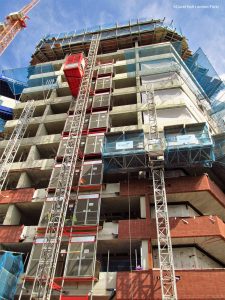
At the Homes 2017 conference, a panel discussion was held to discuss the importance of involving tenants in the regeneration of estates. LABM’s Sophie Taylor finds out more from the event.
The discussion about regenerating estates in partnership with tenants was held between Philip Glanville, Mayor of Hackney Council; Helen Evans, Chief Executive of Network Homes; John Giesen, Chair of Tpas; Victoria Hills, Chief Executive of Old Oak and Park Royal Development Corporation; and chaired by Andy von Bradsky, Chair of The Housing Forum.
Regeneration projects can be controversial and create difficult relationships between tenants and their landlord — be they local authorities, ALMOs or housing associations. For this reason, many landlords have considered the importance of regenerating estates in partnership with tenants, in order to deliver what is needed for the local community.
Hackney Council
Hackney Council has launched a not-for-profit Estate Regeneration Programme which will see nearly 3,000 council homes built at 18 sites across the borough — more than half of which are for social rent and shared ownership. By taking control of regeneration, it been able to reassure existing tenants that their rights will be guaranteed and that they will remain council tenants on council rent. This is also helping to convince the wider neighbourhood of the council’s commitment to the area, since it will retain the management of the projects once they have been regenerated.

Post-Grenfell, it has been essential for local authorities to regain the trust of tenants and the local community. This was a core ambition for Hackney Council’s regeneration of Colville Estate in Shoreditch. Having been through multiple attempts of regeneration, the relationship between the council and the residents had become very hostile. However, through the local authority new-build programme and by taking the estate back in-house, the council was able to rebuild its relationship with tenants. It worked with residents on the master plan, leading to a resident-led petition in favour of the development.
The council has also committed to following a local sales and marketing strategy, aided by its in-house sales team. Having this strategy allowed the council’s estate regeneration in King’s Crescent, Stoke Newington to avoid selling any homes to foreign investors, and only 5 were sold to Buy to Let investors. This has given new residents trust that Hackney Council is building a community that will be integrated, since there are no private areas of the estate — social tenants, shared owners and private sales are all managed together by the council.
The regeneration of Stockwell Park
To deliver a successful regeneration project, housing providers must be adaptable and flexible. For example, the Stockwell Park regeneration, which began in 2007, had to be completely replanned following the financial crisis.
Despite difficulties during the project, Network Homes adapted its business plan and now considers Stockwell Park, pictured above, to be a successful regeneration in terms of community engagement. However, the process was not simple, and Helen Evans believes that you have to expect a certain level of distrust from the community. Helen commented: “It is important to be open about both the losses and the gains that the project will bring”. Having provided what it had proposed in Stockwell Park — no reduction in social housing, retaining all the local open spaces, refurbishing and demolishing in phases, people who wanted to return were able to return on social rent, refurbishing the community centre, and keeping the local management presence — Network Homes was able to gain the acceptance of the local community.
The tenants’ perspective
It is essential to engage with residents before their help is needed, in order to create a relationship based on communication and trust. John Giesen commented that rather than simply planning changes that landlords think are best for tenants, it is important for them to talk to people and discover their needs. Tpas is a tenant participation advisory service, which focuses on the relationship between landlords and their residents. The organisation has produced a tenant advisor guide to help tenants understand the need for regeneration and building capacity. Its website also provides further information on improving tenant engagement.
Old Oak and Park Royal
Old Oak and Park Royal Development Corporation (OPDC) is the second Mayoral Development Corporation in London. Old Oak and Park Royal is a unique area; being the largest Opportunity Area in the London Plan, the location of a new HS2 station, and the only place where HS2 will meet Crossrail. At the moment, it is mainly brownfield land with very little residents living there. This poses a problem, since many current residents chose the location because it was quiet and sparsely populated.
“It is important to be open about both the losses and the gains that the project will bring.”
Victoria Hills, Chief Executive Officer, argued that it is essential to take the residents on the regeneration journey. Since the new station opens in nine years, the OPDC was established to make the most of the regeneration opportunity by building 25,500 new homes around the station. To help engage and speak with residents about the changes, the OPDC created an engagement team to work with businesses and local residents. Additionally, they used an already existing umbrella organisation in the area that represents the community called the Grand Union Alliance, which gave the OPDC a mechanism for speaking to local people. So far, the OPDC Board has already approved two Neighbourhood Forums which provide a space to discuss issues such as density, affordable homes, and amenity space. Holding public forums and having an open conversation has allowed the OPDC to keep a dialogue with local residents and helped to minimise their displeasure with the changes to the area.
Sharing best practice
Local residents are often able to provide good ideas for regeneration, thanks to their deep understanding of the local area. For this reason, a continuous and open dialogue between landlords and tenants is essential. Tpas offers training and conferences for tenants and staff to teach them about good practice. Howver, Philip Glanville argued that it is also important to share the ideas of tenants on a wider platform, for example by taking them to housing conferences. By engaging with tenants on a wider level, housing providers can develop a better understanding of their needs.
Finally, Philip Glanville argues that there is a skills shortage in the number of project managers and master planners who truly know how to engage and work with residents. Therefore, it is essential to continue to shed light on the importance of these relationships for regeneration projects.








